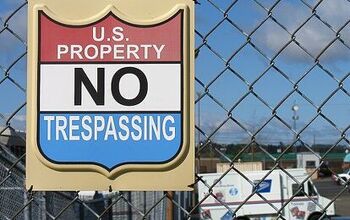Editorial: American Leyland Watch: Plans, Trains and Automobiles
We have met the Obamamobile, and it is a train. Just ask Commerce Secretary Gary Locke. Locke was in Michigan recently, while SecTrans Ray LaHood, VP Joe Biden and MI Governor Jennifer Granholm were discussing a Detroit-Pontiac-Chicago high-speed rail line in Washington, D.C. The HuffPo‘s Susan Demas asked Locke if he saw the rail project as a way to wean Michigan’s manufacturing base off its centuries-long auto addiction. To which Locke replied, “Oh, yeah,” faster than the Kool-Aid man after a post-college Eurorail adventure. “As you see more construction of rail cars, high-speed cars, it’s going to require new engineering, new products and services and that’s the natural fit and extension for automotive dealers and suppliers and manufacturers.” And Demas agrees, arguing that “linking up with rail makes perfect sense for a contracting industry, at a time when environmental and economic factors make expanding public transit a necessity.” Yes, necessity. As in the mother of invention. And political intervention.
Demas does point out that the rail project in question could face political opposition. “It will take a real will on the part of the states and the Congress to get it done,” she quotes former Rep Joe Schwarz (R-MI) as saying. “Members of Congress from non-high-speed rail states will fight it.” Meanwhile, the self-serving dynamic identified by Schwarz illustrates a major problem with the US rail industry, and how (car-to-train transition aside), the US ownership of GM could make it a political pawn at every turn.
Over at The Daily Beast, former GM and Amtrak man James Langenfeld recounts how the publicly-owned rail firm has become a perennial victim of DC’s politics-before-economics. “Amtrak had a government-affairs department rather than a finance department,” he writes. This “proved to be an omen: Train service was provided to states with powerful senators, even if this involved huge losses and few passengers.” A preview of coming factory placements? Meanwhile, at “38 years old and [showing] no sign of moving out of the taxpayer’s house,” Amtrak subsidies are currently $85,000 a year for each employee, or about $35 every time Amtrak sells per ticket sold. In the absence of profitability, Amtrak and now GM merely provide another opportunity to send pork home to the district.
And Langenfeld isn’t the only one who sees parallels between Amtrak and the new Government Motors. “I see no hope whatsoever for the situation,” says Wendell Cox, who served as a policy consultant for the government-appointed Amtrak Reform Council a decade ago. Cox tells Fox News that political considerations have led to poor decisions at Amtrak, “like maintaining costly, long-distance lines and setting up inefficient routes that detour through low-population areas.”
Even among those who support the bailout and improvements to America’s rail system, there should be concern about any mention of the auto and rail industries in the same breath. After all, the government’s open-ended commitment to GM is sure to become a focal point for political opposition to the Obama administration. And for those who are already disposed towards criticism of Obama, Amtrak is a preeminent symbol of government mismanagement. From George Will to the National Review‘s K-Lo to Ron Paul, GM-as-Amtrak is becoming the meme of choice for the emerging anti-auto-bailout mainstream. Anyone who thinks GM won’t be held hostage to political battles clearly has another think coming.
And though Amtrak has the excuse that rail industries are typically subsidized by governments, GM can’t fall back on the “everyone’s doing it” argument. Meanwhile, suggesting that the auto industry should look to yet another government-stimulated sector as a way forward provides further incentives to accept mediocrity in its automotive products. All of which illustrates how slippery the bailout slope really is. Remember, the bailout has been justified since day one with rhetoric about the unique role of the automobile industry in American life. If there’s any possibility for hope in the emerging American Leyland, it comes from the ability to invest huge amounts of money at a time when the auto industry is going through a period of transformative change. Rail business is a distraction at best, and a life sentence of government angency-dom at worst.
Locke’s talk of “transitioning” the auto industry towards rail shows exactly how far politics could go towards affecting the future of the new Government Motors. And without a clear exit strategy, there’s no telling where it could end. There’s nothing inherently wrong with more rail transportation in the US, but painting the rail biz as an alternative for a struggling US auto industry ignores the ugly reality of public Amtrak ownership. As badly as GM has done building cars for several decades, it will either exit Uncle Sam’s nest on the strength of its cars or face a downward spiral into political adventurism to which there is no bottom. In the case of the latter scenario, the last 30 years of GM’s decline will look like the work of true genius.
More by Edward Niedermeyer
Latest Car Reviews
Read moreLatest Product Reviews
Read moreRecent Comments
- Kwik_Shift_Pro4X Thankfully I don't have to deal with GDI issues in my Frontier. These cleaners should do well for me if I win.
- Theflyersfan Serious answer time...Honda used to stand for excellence in auto engineering. Their first main claim to fame was the CVCC (we don't need a catalytic converter!) engine and it sent from there. Their suspensions, their VTEC engines, slick manual transmissions, even a stowing minivan seat, all theirs. But I think they've been coasting a bit lately. Yes, the Civic Type-R has a powerful small engine, but the Honda of old would have found a way to get more revs out of it and make it feel like an i-VTEC engine of old instead of any old turbo engine that can be found in a multitude of performance small cars. Their 1.5L turbo-4...well...have they ever figured out the oil dilution problems? Very un-Honda-like. Paint issues that still linger. Cheaper feeling interior trim. All things that fly in the face of what Honda once was. The only thing that they seem to have kept have been the sales staff that treat you with utter contempt for daring to walk into their inner sanctum and wanting a deal on something that isn't a bare-bones CR-V. So Honda, beat the rest of your Japanese and Korean rivals, and plug-in hybridize everything. If you want a relatively (in an engineering way) easy way to get ahead of the curve, raise the CAFE score, and have a major point to advertise, and be able to sell to those who can't plug in easily, sell them on something that will get, for example, 35% better mileage, plug in when you get a chance, and drives like a Honda. Bring back some of the engineering skills that Honda once stood for. And then start introducing a portfolio of EVs once people are more comfortable with the idea of plugging in. People seeing that they can easily use an EV for their daily errands with the gas engine never starting will eventually sell them on a future EV because that range anxiety will be lessened. The all EV leap is still a bridge too far, especially as recent sales numbers have shown. Baby steps. That's how you win people over.
- Theflyersfan If this saves (or delays) an expensive carbon brushing off of the valves down the road, I'll take a case. I understand that can be a very expensive bit of scheduled maintenance.
- Zipper69 A Mini should have 2 doors and 4 cylinders and tires the size of dinner plates.All else is puffery.
- Theflyersfan Just in time for the weekend!!! Usual suspects A: All EVs are evil golf carts, spewing nothing but virtue signaling about saving the earth, all the while hacking the limbs off of small kids in Africa, money losing pits of despair that no buyer would ever need and anyone that buys one is a raging moron with no brains and the automakers who make them want to go bankrupt.(Source: all of the comments on every EV article here posted over the years)Usual suspects B: All EVs are powered by unicorns and lollypops with no pollution, drive like dreams, all drivers don't mind stopping for hours on end, eating trays of fast food at every rest stop waiting for charges, save the world by using no gas and batteries are friendly to everyone, bugs included. Everyone should torch their ICE cars now and buy a Tesla or Bolt post haste.(Source: all of the comments on every EV article here posted over the years)Or those in the middle: Maybe one of these days, when the charging infrastructure is better, or there are more options that don't cost as much, one will be considered as part of a rational decision based on driving needs, purchasing costs environmental impact, total cost of ownership, and ease of charging.(Source: many on this site who don't jump on TTAC the split second an EV article appears and lives to trash everyone who is a fan of EVs.)


































Comments
Join the conversation
Detroit, Pontiac, Chicago? Pontiac? This makes no sense to me. But if Government is making the decisions, then we must be happy with it! Term limits, please... Why not put a hub in Toledo and service Cleveland, Detroit, Chicago, Columbus, and maybe even Cincinnatti? You could build much of the rail out along the 80/90 corridor, and use I-75 for the Detroit and Cinci legs. Or do it right, and build the damned thing right on top of the 80/90 median. Then you can go as fast as you damned well please. But this is all pie-in-the-sky. There are three big problems with city-to-city rail. First, ever since the train bombings in England, France, and Spain, you have to assume that trains and rails are potential terrorist targets. It's decidedly more difficult to protect hundreds or thousands of miles of unattended track than it is to protect planes at their arrival and departure points. Until we begin thinking about enacting the death penalty for terrorist activity, I don't think rail systems will be safe enough to justify using. Terrorists have a high repeat-offender rate, and I want to see this stopped. Until then, I'd rather drive my GPS-equipped car. Second, what cities do you serve, and who do you leave off the list? Why not add Flint, Ann Arbor, and Lansing to my idea? Don't the people in Marquette deserve a fast way to get to Cleveland to see the game? The third big problem is that once you get your passengers to the city, then they have to actually get to their final destinations. What do they do, rent a car? If they rode a subsidized train in the first place, they're probably not financially prepared for renting a car. So do we subsidize this too? Aaah, but there's the already-subsidized bus. Let's talk about that. Public local transportation is often too inconvenient (a lot of cities' buses all go downtown before going where you REALLY need to go), not to mention the dodgy neighborhoods in which you typically find local bus stations, making it inconvenient or downright unsafe for out-of-towners. And the alternative, having multiple in-city stops (for the fast train), is not appealing either. Who wants to delay getting the hell OUT of Detroit by another 45 minutes waiting for the people in Troy, then Warren, then downtown Detroit, then Wyandotte or some such place to get on the damned train and stow their strollers, motorbikes, and televisions (you would not believe what people feel they must bring with them when they travel). My point is, you can subsidize this train all you want with money stolen from the taxpayer. And you can justify it by making claims (which may be true) that "all transportation is subsidized to some extent, so we might as well proceed," but that doesn't make it something other than theft, which is what it is when I pay for something I don't want, need, use, or choose. Nor does it make this a good idea. The ONLY way subsidized high-speed, long range trains will succeed is when they're made so bad that average people won't use them because they're too scared or too dignified to subject themselves to the time, inconvenience, and potential dangers. Don't get me wrong; I like the idea of mass-transit. But this is not a utopia, and evidence to date shows that we just don't do it well when the government gets involved. Therefore, I vote "no" to using public money for this! Instead, I say let's encourage private industry to come up with a solution to serve the cities that would turn a profit, and let's let them serve their customer and grow themselves like a business.